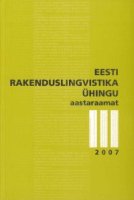Võimalusi helistaja identifitseerimiseks institutsionaalses telefonisuhtluses
Caller identification in institutional telephone conversation
Author(s): Andriela RääbisSubject(s): Language and Literature Studies
Published by: Eesti Rakenduslingvistika Ühing (ERÜ)
Keywords: spoken Estonian; conversation analysis; interaction in institutional settings; telephone conversation
Summary/Abstract: The analysis is based on the transcriptions of 684 institutional phone conversations in Estonian (91 289 tokens in total). Ten situational groups are represented : 413 directory inquiries, 62 calls to travel agencies, 65 calls to outpatients’ offices, 42 calls to service encounters, 14 telemarketing calls, 14 calls to bus stations, 13 calls to civil services, 10 calls to shops, 22 calls for taxi, 29 calls of university colleagues. Communication takes place mostly between strangers, only in 45 dialogues the participants are acquainted. Methodologically the study is based on conversation analysis. If a customer needs some general information, he remains anonymous. Only if requested information is personal or confidential, the customer introduces himself. If a customer expects an action from the addressee (e.g. to book a doctor’s appointment, to send a taxi, to participate in a training course), he introduces himself at the beginning of the conversation, otherwise the operator asks the customer’s data (name, ID code, phone number etc.) later. The first option is characteristic of telemarketing calls: the caller represents an institution and tells his first name, family name and the name of the institution at the beginning of the conversation. An operator asks the caller’s data 1) after the interlocutors have come to an agreement (e.g. the builder called has agreed to repair the garage ); 2) the operator needs more time for finding information and is going to call the customer back (e.g. in calls to travel agencies); 3) the operator fills out a blank (e.g. in the outpatients’ office). There are several types of identification. In some cases identification is necessary for the current conversation: the interlocutors cannot communicate unless the partner is identified. In other cases identification takes place for a consecutive action, e.g. a receptionist needs to know a customer’s name not in order to talk with him but to reserve a room for him.
Journal: Eesti Rakenduslingvistika Ühingu aastaraamat
- Issue Year: 2007
- Issue No: 3
- Page Range: 269-284
- Page Count: 16
- Language: Estonian

